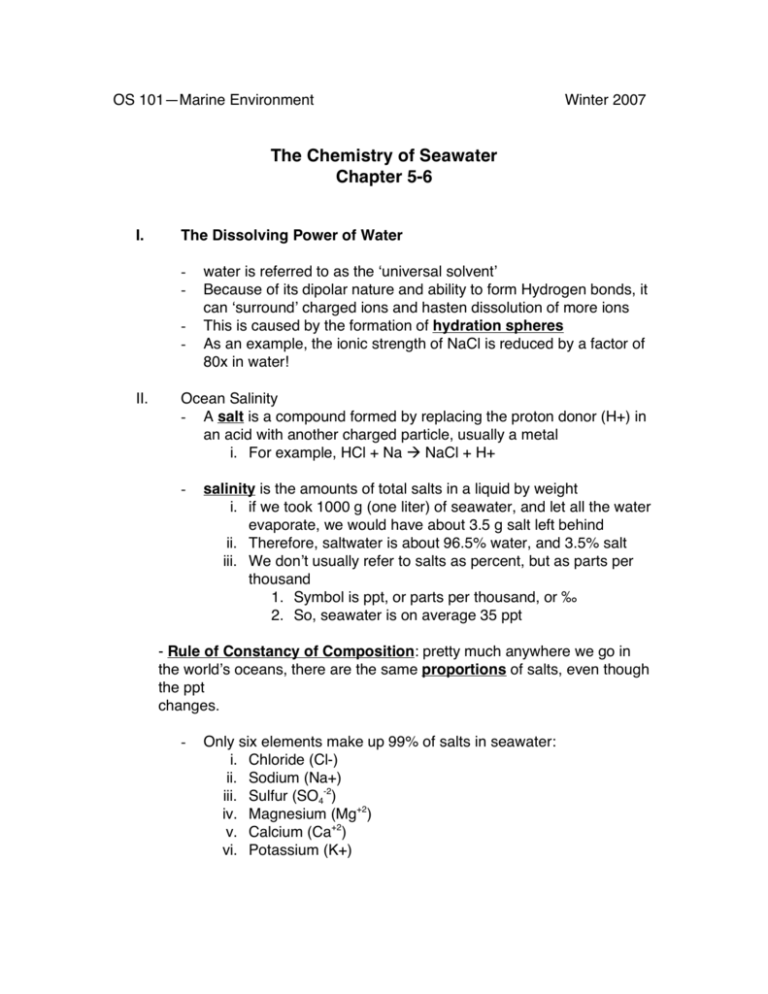The Chemistry of Seawater Chapter 5-6
advertisement

OS 101—Marine Environment Winter 2007 The Chemistry of Seawater Chapter 5-6 I. The Dissolving Power of Water - II. water is referred to as the ‘universal solvent’ Because of its dipolar nature and ability to form Hydrogen bonds, it can ‘surround’ charged ions and hasten dissolution of more ions This is caused by the formation of hydration spheres As an example, the ionic strength of NaCl is reduced by a factor of 80x in water! Ocean Salinity - A salt is a compound formed by replacing the proton donor (H+) in an acid with another charged particle, usually a metal i. For example, HCl + Na NaCl + H+ - salinity is the amounts of total salts in a liquid by weight i. if we took 1000 g (one liter) of seawater, and let all the water evaporate, we would have about 3.5 g salt left behind ii. Therefore, saltwater is about 96.5% water, and 3.5% salt iii. We don’t usually refer to salts as percent, but as parts per thousand 1. Symbol is ppt, or parts per thousand, or ‰ 2. So, seawater is on average 35 ppt - Rule of Constancy of Composition: pretty much anywhere we go in the world’s oceans, there are the same proportions of salts, even though the ppt changes. - Only six elements make up 99% of salts in seawater: i. Chloride (Cl-) ii. Sodium (Na+) iii. Sulfur (SO4-2) iv. Magnesium (Mg+2) v. Calcium (Ca+2) vi. Potassium (K+) - - III. Because of this constancy of composition, we need only measure one element or ion to estimate salinity. Chloride (Cl-) is the easiest to measure, so we used to measure Cli. Salinity ‰ = 1.80655 x Clii. Modern instruments, we rely on the fact that the more ions, the better conductor water is, so we measure conductivity iii. We don’t actually measure salinity (weight), or Cl- (ions) any more…because of that, we switched to the Presumed Salinity Units (psu) designation, since we don’t actually measure it! iv. Most recently, we switched to the Presumed Salinity Scale (pss) because there aren’t actually any units associated with conductivity Besides the 6 major elements, there are many minor ones. The next group, found at 1-100 parts per million (ppm), include Bromine, Carbon, Strontium, Boron, Silicon, Fluorine Then, < 1ppm, Nitrogen, Lithium, Rubidium, Phosphorous Sea Water Density - Density is simply mass per unit volume, typically g/cm3 - It is affected by temperature (expansion/contraction), salinity (adds weight as salts), and Pressure (expansion/contraction) - Because of salts, seawater has a density 2-3% higher than pure water…therefore the density increases from 1.0000 to 1.022-1.030 - In a stable ocean, density always increases with depth (water sinks) - We define density as Sigma (σ) - The temperature of maximum density in freshwater is 3.98°C…which means that as water cools, it sinks You can decrease the temperature of maximum density (and the freezing point) by adding salts…because of that, seawater almost never freezes, because it will sink from the surface before it gets cold enough - - Density is very easy to measure in the laboratory, but very difficult to measure in the ocean. So, we measure the 3 properties that control density: i. Temperature ii. Salinity iii. Pressure IV. - Water is essentially uncompressible, so we often ignore pressure— however, when we think of thousands of meters of seawater, it becomes important. i. Sigma-T refers to the density in situ, at ambient, T, S, P ii. Sigma-Theta is corrected for pressure 1. As pressure increases, there’s slight compression of water 2. This causes adiabatic heating (heating without an input of energy)…bring it to the surface, temperature drops, and becomes more dense 3. Therefore, Sigma-T is always less than Sigma-Theta - We usually convert density numbers to a more convenient scale: i. Specific Gravity = ((density/.999974) – 1)*1000 ii. Easier to use a T-S diagram - Temperature and Salinity are Conservative Properties i. This means they don’t change, except by mixing, once they leave the boundaries (surface or bottom of the ocean) ii. Provides a “fingerprint” for different water masses - In contrast, Non-Conservative Properties can change even though they are not in contact with the boundaries…they are affected by biology. Vertical Profiles - Look at the distribution of temperature, salinity, and density with depth: i. It becomes obvious that density is controlled by temperature ii. In a stable ocean, get layers of density…water is free to circulate in areas of constant density (i.e. mixed layer), but is kept from mixing across boundaries - Regions where the slope changes rapidly are clines: i. Pycnocline—density slope ii. Thermocline—temperature slope iii. Halocline—salinity slope iv. Nutricline—nutrient slope - Isopycnal surfaces are layers where density doesn’t change (in 3dimensions) Isothermal, Isohaline surfaces are same idea, but for temperature and salinity - V. Acidity and Alkalinity - Acid: a compound which, when dissolved in water, forms hydrogen ions - Base: (or alkaline compound), is a hydrogen ion acceptor pH = -log[H+], where [H+] designates the hydrogen ion concentration Since pH is defined as an algorithm, only the exponent of the concentration needs to be used to describe the solution. A pH of 8 means that there are 1x10-8 moles H+ per liter. H20 + H20 H30 + (H+) H2O H+ + OHTherefore, water is a strong acid/base pair, and annihilates each other…the pH ends up being exactly neutral. Another example: H20 + HCl H2O + H+ + Cl-, so it’s more acidic Alkalinity: amount of H+ ions that can be absorbed, or neutralized, by a solution. It buffers the acidity. Seawater is dominated by CO3-2, HCO3-, and OH A = [HCO3] + 2 [CO3] +[OH] –[H] - Seawater pH is about 8.2-8.5, so has about 7x10-9 mols/L H+ - Alkalinity is about 0.0023 mol/L HCO3 equivalents, or about 2x10-3 - Therefore, seawater has 3 million times more buffering capacity than acidity! VI. Chemistry versus Depth - Oxygen is abundant in the near surface, because it is in equilibrium with the atmosphere, and photosynthesis produces oxygen Carbon Dioxide is also at equilibrium in the surface With depth, you go through the oxygen minimum zone, at about 1000m…this is where most organic matter is converted back into CO2 Therefore, CO2 has a mirror-image relationship with depth pH is controlled by CO2, so it drops as CO2 increases VII. Sources of Salts - In the ancient atmosphere, there was much more CO2, sulfur, chlorine because of volcanic activity - These form HCl, HCO3, CO3, H2SO4 - The atmosphere and oceans were much more reducing, which helped to dissolve away the rock minerals - In the modern ocean, the concentration of salts is dependent on how reactive they are…if they aren’t very reactive, the concentration stays extremely constant (Na, Cl), while if they are very reactive, they show strong gradients (Fe) - Biogeochemical Cycles: describes the sources, sinks, and fluxes of elements through the oceans, atmosphere, and land…same as the hydrologic cycle, except instead of water, we’re looking at other elements - Major Biogeochemical Cycles: i. Carbon 1. Actually driven by carbonate chemistry and the balance between the oceans and atmosphere, and by the effects of biology on the inorganic carbon 2. “Solubility Pump” is simply the “pumping” of carbon from the surface to depth by the change in solubility as pressure increases and temperature decreases 3. “Biological Pump” is the packaging of inorganic carbon as organic material, which is rapidly exported to depth as organic matter (often fecal pellets). Sometimes referred to as the “fecal express” 4. Carbonate Compensation Depth (CCD) is the point at which carbonate is soluble in seawater. Below that depth, carbonate will dissolve if exposed to seawater ii. Phosphorous 1. Geologists think of phosphorous as being the single most limiting element in the ocean for biology 2. Primary source of phosphorous is from rocks 3. Phosphorous is very particle reactive, so it is not present in very high concentrations 4. In the oceans, phosphorous is primarily regenerated at depth, and the major source is upwelling of deep, nutrient rich water, but it is also regenerated quickly, so it spends a lot of time being recycled in the surface waters iii. Nitrogen 1. Geologists consider it to be non-limiting (biologically) because there is always more available from the atmosphere, via nitrogen fixation. 2. Biologists argue that on shorter time scales, nitrogen is very limiting in the oceans (more than phosphorous) 3. Very complicated biogeochemical cycling, with many sources and sinks, and several forms of nitrogen (nitrate, nitrite, ammonium, urea, amino acids, nitrogen gas, etc) 4. Nitrogen is not regenerated as quickly as phosphorous in the surface ocean, but there is a lot of recycling relative to other elements (such as silicon) iv. Silicon 1. Only used by diatoms and radiolarians in the modern ocean 2. Limits production of diatoms in some regions 3. ALWAYS undersaturated in the ocean (always dissolves), so there is no equivalent of the CCD 4. Regeneration is limited in the surface ocean, so silicon is exported from the surface to depth much more efficiently than either C, N, or P. 5. Primary sources of Si are upwelled deep waters and river water (dissolved terrestrial rocks) v. Iron 1. Very scarce in the oceans (it is a “trace metal”) 2. In large regions of the ocean, it may limit biological productivity 3. Primary sources are atmospheric, terrestrial (rivers), and benthic (sediments), so it is most limiting in deep waters with no upwelling far from land VIII. Box Models - If we want to look at biogeochemical cycles, we often use box models - A box model is simply a schematic representation of a system that is assumed to be in steady state, meaning that it is in balance (the ins and outs equal each other) - Box models get their name because each part of the model (the oceans, for example) is described as a box, which has some volume, some concentration (whatever you’re modeling), and inflows/outflows.








